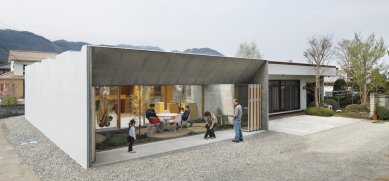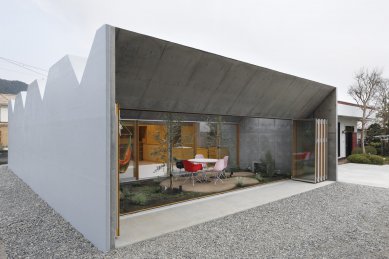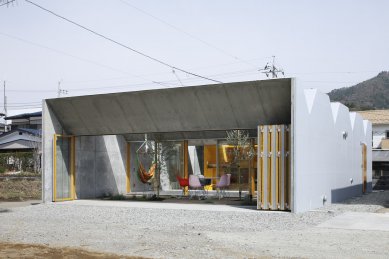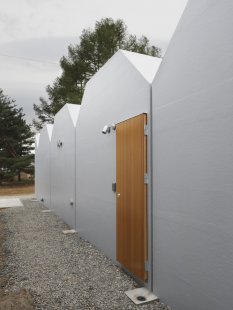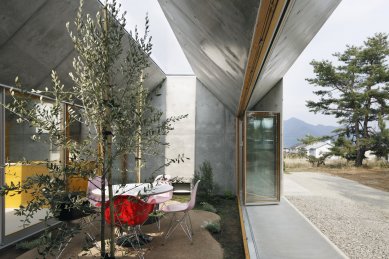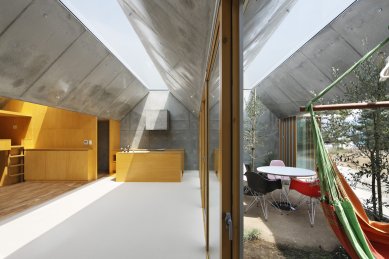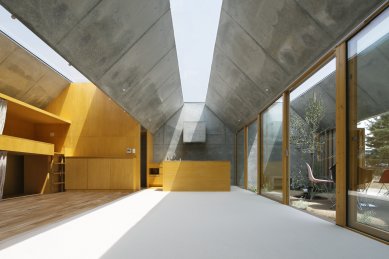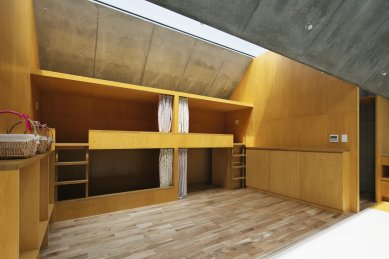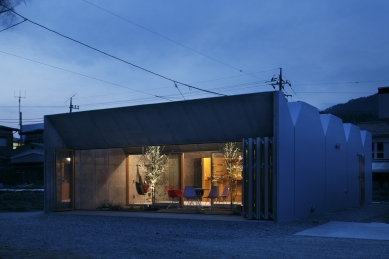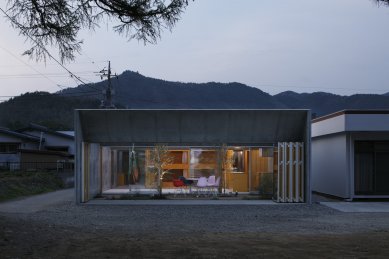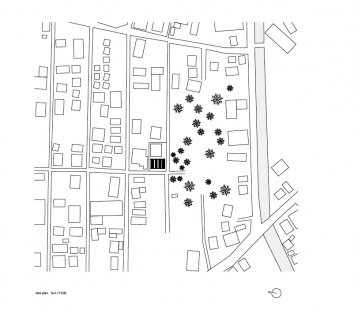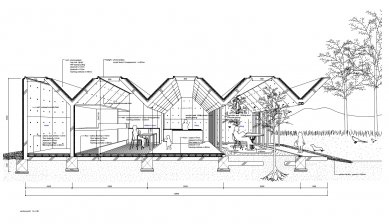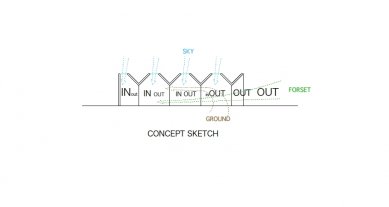
Outside In House

Gradation of scenery, from outdoor area to inside area
The project was launched when I was commissioned to enlarge a house for a couple in their 30′s and their three daughters living in Yamanashi Prefecture. On my first visit there, I found the houses of one story and two stories both stand close together but that there remain some empty lots, farming fields, wooded areas and unpaved roads. I remember that the bounty and generosity of the place inspired me. My client told me that we would have the opportunity to hear beautiful sound of birds in the early mornings and to see wild pheasants, peafowl and every now and then raccoon dogs. I looked for how the residents here could live in harmony with such nature and climate even in a crowded residential area. In the beginning I destroyed half of the main house, and then designed and built a new, one-storied structure with a continuous gradation from the wooded area located on the south side of the house to the inside area – that is, it is a boundary structure built in space between nature and human beings.
Sky above, forest sidelong, ground below
The sky being above the house, the forest close to the house, and the ground below the house, nature is attractive enough to be taken in into the inside area of the house. I planned a structure in which nature is horizontally and vertically incorporated as an integral part of the design of the structure to create a gradation from the outside area to the inside areas. To put it concretely, the open shed lies facing the south, which makes it possible for the residents to feel as if they were in one room, filled with a sense of unity with the wooden area.
And the upper part of the house also has an open structure, consisting of some combinations of reinforced concrete V beams and transparent acrylic, as a result of which the residents can see the sky through the transparent acrylic ceiling. The V-beam structure conveys an impression of durability and reliability, while the presence of the transparent acrylic is next to nothing, which enables us to ignore the acrylic unconsciously and see only the rows of reinforced concrete V beams. What comes into our eyes is nothing but the beams, so we feel the sky so close to us, being unconscious of the existence of the roof. And the dining room is located at the end of the house, which is a boundary area between outside area and insider area in terms of the gradation. I regarded the floor of the dining room as comprising a part of the ground, and therefore I planted flowers and trees there.
Enjoyment of climate
In winter, the temperature here gets -10 C. However, the residents of this house do not need to stay still home during the long winter months. They can positively enjoy the climate in their own house, feeling the outside physically and spiritually. The cries of wild pheasants echo in the morning air, and will wake the residents up. The peacocks can be seen from their bedroom, and they can enjoy eating in the dining room where flowers and trees are growing up. During hot summer months, with no air conditioners, opening the window to its full width is to exchange the air inside with the air outside, which is a kind of synchronization of inside and outside temperature. Even on the rainy days when the rain blows into the room, they do not need to hurry to close the window because the floor of the room is a kind of a flower bed. In the residential area stands the house with the gradation of scenery positively open to the climate, filled with bounty and generosity.
The project was launched when I was commissioned to enlarge a house for a couple in their 30′s and their three daughters living in Yamanashi Prefecture. On my first visit there, I found the houses of one story and two stories both stand close together but that there remain some empty lots, farming fields, wooded areas and unpaved roads. I remember that the bounty and generosity of the place inspired me. My client told me that we would have the opportunity to hear beautiful sound of birds in the early mornings and to see wild pheasants, peafowl and every now and then raccoon dogs. I looked for how the residents here could live in harmony with such nature and climate even in a crowded residential area. In the beginning I destroyed half of the main house, and then designed and built a new, one-storied structure with a continuous gradation from the wooded area located on the south side of the house to the inside area – that is, it is a boundary structure built in space between nature and human beings.
Sky above, forest sidelong, ground below
The sky being above the house, the forest close to the house, and the ground below the house, nature is attractive enough to be taken in into the inside area of the house. I planned a structure in which nature is horizontally and vertically incorporated as an integral part of the design of the structure to create a gradation from the outside area to the inside areas. To put it concretely, the open shed lies facing the south, which makes it possible for the residents to feel as if they were in one room, filled with a sense of unity with the wooden area.
And the upper part of the house also has an open structure, consisting of some combinations of reinforced concrete V beams and transparent acrylic, as a result of which the residents can see the sky through the transparent acrylic ceiling. The V-beam structure conveys an impression of durability and reliability, while the presence of the transparent acrylic is next to nothing, which enables us to ignore the acrylic unconsciously and see only the rows of reinforced concrete V beams. What comes into our eyes is nothing but the beams, so we feel the sky so close to us, being unconscious of the existence of the roof. And the dining room is located at the end of the house, which is a boundary area between outside area and insider area in terms of the gradation. I regarded the floor of the dining room as comprising a part of the ground, and therefore I planted flowers and trees there.
Enjoyment of climate
In winter, the temperature here gets -10 C. However, the residents of this house do not need to stay still home during the long winter months. They can positively enjoy the climate in their own house, feeling the outside physically and spiritually. The cries of wild pheasants echo in the morning air, and will wake the residents up. The peacocks can be seen from their bedroom, and they can enjoy eating in the dining room where flowers and trees are growing up. During hot summer months, with no air conditioners, opening the window to its full width is to exchange the air inside with the air outside, which is a kind of synchronization of inside and outside temperature. Even on the rainy days when the rain blows into the room, they do not need to hurry to close the window because the floor of the room is a kind of a flower bed. In the residential area stands the house with the gradation of scenery positively open to the climate, filled with bounty and generosity.
3 comments
add comment
Subject
Author
Date
výstava
Tomáš Zdvihal
11.10.12 09:53
rozloha pozemku
Zuzana Froňková
11.10.12 09:11
způsob uvažování
šárka
11.10.12 12:49
show all comments


